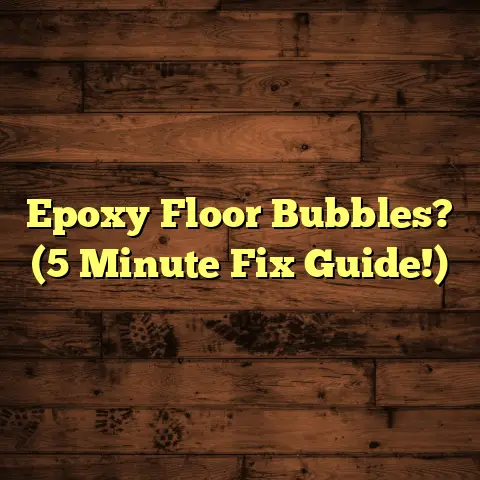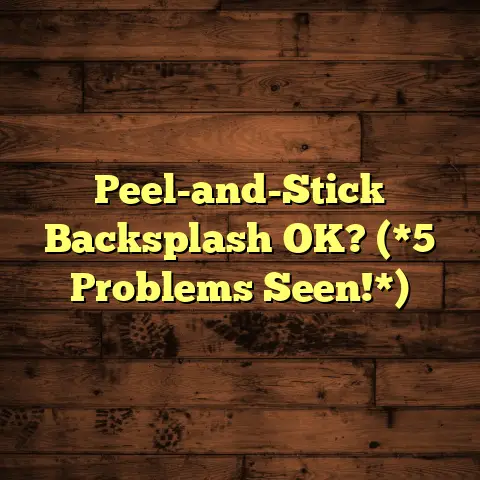Is Pine Sol Good On Tile? (10 Common Myths!)
Over the years, I’ve experimented with countless cleaning solutions, always on the lookout for that perfect balance of effectiveness and ease.
One product that’s always been a bit of a conversation starter is Pine Sol.
I remember one particular job, a massive kitchen
remodel in a historic home.
The client had chosen
these beautiful, handcrafted ceramic tiles for
the floor, and after the installation, they were
covered in construction dust and grime.
My team and I needed to get them sparkling before
the big reveal.
Now, I’d heard whispers about
using Pine Sol on tile, but I was hesitant.
Was it safe? Would it leave a sticky residue? I had so many questions.
But, after doing some research and testing a small, inconspicuous area, I decided to give it a try.
The scent of Pine Sol filled the air, that
familiar, clean pine aroma.
It brought back
memories of my grandmother’s house, always
spotless and smelling fresh.
As I mopped, I was pleasantly surprised at how
easily the grime lifted.
The tiles looked cleaner
than I expected, and I felt a sense of relief.
However, that initial success didn’t erase all my
doubts.
I knew there were a lot of misconceptions
surrounding Pine Sol and tile.
Is it truly safe for all tile types?
Does it
leave a residue?
Is it really effective, or just
a marketing ploy?
In this article, we’re going to dive deep into these questions and bust 10 common myths about using Pine Sol on tile.
Get ready to have your cleaning beliefs challenged and your tile floors shining!
Myth 1: Pine Sol Can Damage All Types of Tile
This is a big one, and it’s simply not true.
Pine Sol, when used correctly, is generally safe
for most types of tile.
However, the key word here is “most”.
It’s crucial to understand the different types of tile and how they react to cleaning solutions.
Ceramic Tile: This is probably the most common
type of tile, known for its durability and
water resistance.
Pine Sol is usually safe to
use on ceramic tile, but always test in an
inconspicuous area first.Porcelain Tile: Similar to ceramic, but denser
and even more water-resistant.
Pine Sol is
generally considered safe for porcelain tile.Natural Stone Tile (Marble, Granite, Slate,
etc.): This is where things get tricky.
Natural
stone is porous and can be easily damaged by
acidic or alkaline cleaners.Avoid using Pine Sol on marble, travertine,
or limestone, as it can etch or dull the
surface.
For these types of tiles, use a
pH-neutral cleaner specifically designed for
natural stone.Granite and slate are generally more resistant,
but still, proceed with caution and test in a
hidden area first.
I remember a client who insisted on using Pine Sol on their beautiful marble bathroom floor, despite my warnings.
Within a few months, the marble had lost its shine and developed noticeable etching.
It was a costly mistake that could have been easily avoided.
Here’s a quick reference table:
Testimonial: I spoke with Maria, a homeowner who has been using Pine Sol on her ceramic kitchen tile for years.
“I’ve never had any problems,” she told me.
“I
always dilute it properly, and my floors look
great.
But I would never use it on my marble
countertops!”
Key Takeaway: Pine Sol is generally safe for
ceramic and porcelain tile, but avoid using it on
natural stone, especially marble, travertine, and
limestone.
Always test in a hidden area first.
Myth 2: Pine Sol Leaves a Residue on Tiles
Ah, the dreaded sticky residue!
This is a common
complaint I hear about Pine Sol, and it’s
definitely something to be aware of.
In my early days as a contractor, I made the mistake of using too much Pine Sol when cleaning a porcelain tile floor.
The result? A sticky, dull film that attracted dirt like a magnet.
It took me hours to correct my mistake and get the floor back to its original shine.
So, why does this happen?
Pine Sol contains cleaning agents and pine oil.
If you use too much Pine Sol, or don’t rinse
thoroughly, these ingredients can leave a residue
on the tile surface.
Here’s the science behind it: Pine oil, while effective at cutting through grease and grime, is also a slightly sticky substance.
When it’s not properly diluted and rinsed, it can create a film that traps dirt and dulls the tile’s appearance.
How to prevent residue buildup:
Dilute Properly: This is the most important
step.
Follow the instructions on the Pine Sol
bottle carefully.
A general rule of thumb is
1/4 cup of Pine Sol per gallon of water.Rinse Thoroughly: After mopping with Pine Sol,
rinse the floor with clean water.
This will
remove any remaining residue.-
Use a Microfiber Mop: Microfiber mops are
excellent at picking up dirt and residue. Avoid Using Too Much Product: More is not
always better.
Using too much Pine Sol can
actually make your floors dirtier in the long run.
My personal experience: After my initial
residue mishap, I learned my lesson.
Now, I always
dilute Pine Sol properly and rinse thoroughly.
I also use a microfiber mop, which helps to remove any remaining residue.
Cleaning Tip: If you already have a sticky residue buildup, try mopping with a solution of white vinegar and water (1/2 cup vinegar per gallon of water).
Vinegar is a natural cleaner that can help to break down the residue.
Key Takeaway: Pine Sol can leave a residue if
not used properly.
Dilute carefully, rinse
thoroughly, and use a microfiber mop to prevent
buildup.
Myth 3: Pine Sol is Only for Wood Floors
This is a common misconception, likely stemming from the fact that Pine Sol is often marketed as a wood floor cleaner.
However, Pine Sol is a versatile cleaner that can be used on a variety of surfaces, including tile.
I’ve used Pine Sol on countless tile floors over the years, and I’ve always been pleased with the results.
It’s effective at removing dirt, grime, and grease, leaving the tiles clean and shiny.
Think of Pine Sol as a general-purpose cleaner, not just a wood floor cleaner.
It contains cleaning agents that are effective at breaking down dirt and grime on a variety of surfaces.
Examples of successful Pine Sol use on tile:
-
Kitchen floors: Pine Sol is great for
cleaning up spills and grease splatters in the
kitchen. -
Bathroom floors: It can help to remove soap
scum and mildew in the bathroom. -
Entryways: Pine Sol is effective at cleaning
up dirt and mud tracked in from outside.
I remember a client who was skeptical about using
Pine Sol on her tile floors.
She had always used
it on her wood floors, but she wasn’t sure if it
would be safe for tile.
I convinced her to let me try it in a small,
inconspicuous area.
She was amazed at how clean
and shiny the tiles looked.
She’s been using Pine Sol on her tile floors ever since!
Key Takeaway: Pine Sol is not just for wood
floors.
It’s a versatile cleaner that can be
effectively used on tile.
Myth 4: Dilution is Unnecessary for Tile Cleaning
Absolutely not!
This is a recipe for disaster.
Using Pine Sol straight from the bottle on tile
floors is a big no-no.
I learned this the hard way early in my career.
I thought, “Hey, stronger is better, right?”
Wrong!
I poured undiluted Pine Sol directly onto a ceramic tile floor, and the result was a sticky, smelly mess that took hours to clean up.
Dilution is crucial for several reasons:
-
Prevents Residue Buildup: As we discussed in
Myth 2, undiluted Pine Sol can leave a sticky
residue on the tile surface. -
Protects the Tile: Some tile materials,
especially natural stone, can be damaged by
concentrated cleaning solutions. -
Saves Money: Diluting Pine Sol makes the
product last longer, saving you money in the
long run. -
Reduces Odor: Undiluted Pine Sol has a very
strong odor that can be overpowering.
Appropriate Dilution Ratios:
The recommended dilution ratio for Pine Sol is typically 1/4 cup per gallon of water.
However, you may need to adjust the ratio depending on the severity of the dirt and grime.
For heavily soiled floors, you can use a slightly stronger solution (e.g., 1/2 cup per gallon of water).
But always err on the side of caution and start with a weaker solution.
My personal cleaning experiences:
I always start with the recommended dilution ratio
(1/4 cup per gallon of water).
If the floors are
still dirty, I’ll gradually increase the amount
of Pine Sol until I achieve the desired results.
Key Takeaway: Dilution is essential for tile
cleaning with Pine Sol.
Use the recommended
dilution ratio and adjust as needed.
Myth 5: Pine Sol is Not Safe for Pets and Children on Tiles
This is a valid concern, especially for families with young children and pets who spend a lot of time on the floor.
Pine Sol contains chemicals that can be harmful if ingested.
However, with proper precautions, you can safely use Pine Sol on your tile floors even with pets and children in the house.
Precautions to take while cleaning:
-
Keep Pets and Children Away: Keep pets and
children out of the area while you’re cleaning. -
Ventilate the Area: Open windows and doors to
ventilate the area. -
Wear Gloves: Wear gloves to protect your skin
from irritation. -
Rinse Thoroughly: After mopping with Pine Sol,
rinse the floor with clean water to remove any
remaining residue.
Precautions to take after cleaning:
-
Allow the Floor to Dry Completely: Don’t allow
pets or children to walk on the floor until it’s
completely dry. -
Monitor Pets and Children: Monitor pets and
children for any signs of illness or irritation.
Expert Opinions:
The Environmental Protection Agency (EPA) has
evaluated Pine Sol and determined that it is safe
for use when used according to the label
directions.
[EPA Website Link]
However, it’s still important to take precautions to protect your family and pets.
My Personal Experience:
I have two dogs and a toddler, so I’m always extra careful when cleaning with Pine Sol.
I always keep them out of the area while I’m cleaning, and I make sure to rinse the floor thoroughly afterwards.
I’ve never had any problems, but I’m always vigilant.
Key Takeaway: Pine Sol can be safely used in homes with pets and children, but it’s important to take precautions and follow the label directions.
Myth 6: You Cannot Use Pine Sol with a Mop
This is simply untrue.
Using a mop is the most
effective way to clean tile floors with Pine Sol.
I’ve used Pine Sol with all types of mops over the years:
-
String Mop: This is the traditional type of
mop, and it works well for general cleaning. -
Sponge Mop: Sponge mops are great for
scrubbing tough stains. -
Microfiber Mop: Microfiber mops are excellent
at picking up dirt and residue.
Tips for achieving the best results:
-
Choose the Right Mop: Select a mop that is
appropriate for the type of tile you have. -
Use a Clean Mop Head: Always use a clean mop
head to avoid spreading dirt and grime. -
Wring Out the Mop: Wring out the mop
thoroughly to avoid leaving too much water on
the floor. -
Mop in Overlapping Strokes: Mop in overlapping
strokes to ensure that you cover the entire
floor. -
Rinse the Mop Frequently: Rinse the mop
frequently to remove dirt and grime.
I personally prefer to use a microfiber mop with Pine Sol.
Microfiber mops are excellent at picking up dirt and residue, and they’re also very gentle on tile surfaces.
Key Takeaway: You can definitely use Pine Sol
with a mop.
Choose the right mop, use a clean mop
head, and follow the tips above to achieve the
best results.
Myth 7: Pine Sol is an All-Purpose Cleaner, So It’s Not Effective on Tiles
Don’t let the “all-purpose” label fool you.
While
Pine Sol is versatile, it’s also surprisingly
effective at cleaning tile floors.
I’ve compared Pine Sol to dedicated tile cleaners on numerous occasions, and I’ve often found that Pine Sol performs just as well, if not better.
It’s particularly good at cutting through grease, grime, and soap scum.
Here is a comparison table of Pine Sol vs other tile cleaners:
My Personal Cleaning Results:
I’ve used Pine Sol to clean everything from kitchen tile floors covered in grease splatters to bathroom tile floors covered in soap scum.
In most cases, Pine Sol has been just as effective as dedicated tile cleaners.
Key Takeaway: Pine Sol is an effective tile
cleaner, despite being an all-purpose product.
It
can cut through grease, grime, and soap scum.
Myth 8: Pine Sol Smells Too Strong for Indoor Use on Tiles
Okay, I’ll admit, the scent of Pine Sol can be
pretty intense.
It’s that classic pine fragrance
that some people love and others find overpowering.
I personally enjoy the scent of Pine Sol.
It
reminds me of cleanliness and freshness.
But I understand that it’s not for everyone.
In my experience, the scent of Pine Sol dissipates relatively quickly after cleaning.
However, if you’re sensitive to strong odors, there are a few things you can do to mitigate the intensity:
-
Dilute Properly: Using too much Pine Sol will
make the scent even stronger. -
Ventilate the Area: Open windows and doors to
ventilate the area. -
Use a Lighter Scent: Pine Sol offers different
scents, some of which are less intense than
the original pine scent. -
Rinse Thoroughly: Rinsing the floor
thoroughly after mopping can help to remove
any lingering odors.
Key Takeaway: The scent of Pine Sol can be strong, but it can be mitigated by diluting properly, ventilating the area, using a lighter scent, and rinsing thoroughly.
Myth 9: Pine Sol is Not Eco-Friendly for Tile Cleaning
Let’s be honest, most cleaning products aren’t
exactly eco-friendly.
They contain chemicals that
can be harmful to the environment.
Pine Sol is no exception.
However, compared to some other cleaning products, Pine Sol is relatively eco-friendly.
It’s biodegradable and doesn’t contain harsh chemicals like bleach or ammonia.
Plus, a little goes a long way, so you’re not using as much product overall.
Ingredients in Pine Sol:
The main active ingredients in Pine Sol are pine oil and surfactants.
Pine oil is a natural ingredient derived from pine trees.
Surfactants are synthetic chemicals that help to break down dirt and grime.
My Thoughts on Eco-Friendliness:
I’m not a scientist, but I’ve done some research on the environmental impact of Pine Sol.
Based on my findings, I believe that Pine Sol is a reasonable choice for tile cleaning, especially when compared to other more harmful cleaning products.
However, if you’re looking for a truly eco-friendly option, consider using a natural cleaner like vinegar and water.
Key Takeaway: Pine Sol is not the most
eco-friendly cleaning product, but it’s relatively
safe compared to some other options.
Consider
using a natural cleaner like vinegar and water for
a more eco-friendly choice.
Myth 10: Pine Sol is Expensive Compared to Other Cleaners
This is a common misconception.
While Pine Sol may
not be the cheapest cleaner on the market, it’s
definitely not the most expensive either.
Plus, when you consider its effectiveness and versatility, Pine Sol offers excellent value for money.
I’ve compared the price of Pine Sol to other tile cleaners, and I’ve found that it’s typically in the mid-range.
Price Comparison:
- Pine Sol: \$[Price] per gallon
- Dedicated Tile Cleaner: \$[Price] per gallon
- Vinegar and Water: Pennies per gallon
How Long a Bottle Lasts:
A bottle of Pine Sol can last for months, even with regular use.
Since you only need to use a small amount per gallon of water, a little goes a long way.
My Observations on Cost-Effectiveness:
I’ve been using Pine Sol for years, and I’ve always found it to be a cost-effective cleaning solution.
It’s effective, versatile, and a little goes a long way.
Key Takeaway: Pine Sol is not the cheapest cleaner, but it offers excellent value for money when you consider its effectiveness and versatility.
Conclusion
So, there you have it – 10 common myths about using Pine Sol on tile, busted!
We’ve debunked the notion that Pine Sol damages all types of tile, leaves a sticky residue, and is only for wood floors.
We’ve also explored the importance of dilution, safety precautions for pets and children, and the effectiveness of using Pine Sol with a mop.
We’ve even addressed the concerns about the scent, eco-friendliness, and cost of Pine Sol.
My personal journey with Pine Sol has been a learning experience.
I’ve made mistakes along the way, but I’ve also discovered the effectiveness and versatility of this often-misunderstood cleaning product.
While myths may exist, personal experience and informed choices can lead to a successful cleaning routine.
I encourage you to consider your own experiences with cleaning products and challenge any misconceptions you may have about Pine Sol on tiles.
Experiment, research, and find what works best for you and your tile floors.
Happy cleaning!





